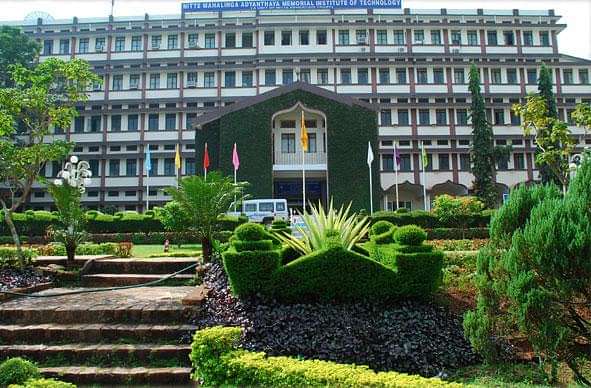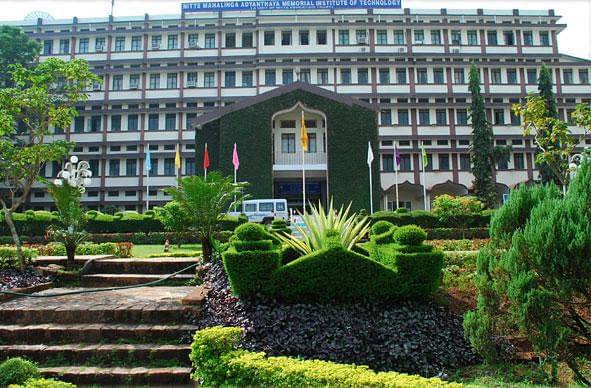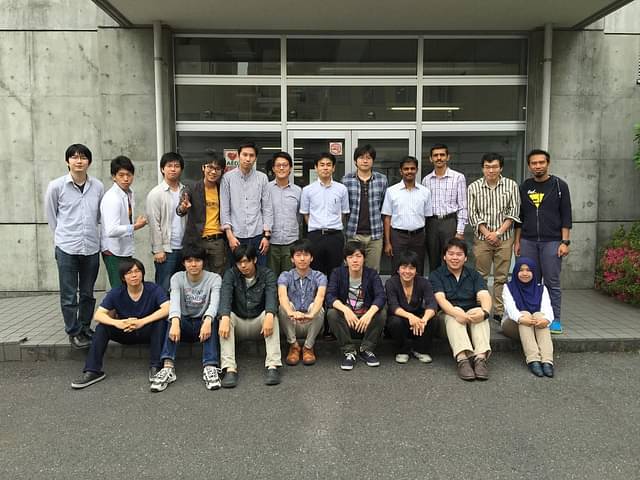NMAM Institute of Technology Latest Updates
About NMAM Institute of Technology
NMAM Institute of Technology, also known as NMAM is a Private, established in 1986. Located in Udupi, NMAM Institute of Technology campus spans over 130 acres. The college is affiliated to Visvesvaraya Technological University (formerly), now part of Nitte University and recognized by the Approved by AICTE. NMAM Institute of Technology is ranked 101-150 in NIRF Engineering by NIRF under Tier-II in 2023. NIRF ranking: 101-150 in NIRF Engineering
NMAM Institute of Technology offers a wide range of Undergraduate, Postgraduate, Doctoral programs in the streams of Tier-II. B.Tech, M.Tech, MBA, MCA are some of the popular courses. Admissions at NMAM Institute of Technology are based on Merit-based on entrance exams. The college accepts COMEDK UGET, KCET for B.Tech, GATE, PGCET for M.Tech, KMAT for MBA. For placements, NMAM Institute of Technology placement rate is 90%%. During the placement drive of 2024, the highest salary package offered was INR INR 52.63 LPA LPA and the average package stood at INR INR 8.1 LPA.
NMAM Institute of Technology Highlights
Some of the major highlights related to NMAM Institute of Technology are listed in the table below:
| Particulars | NMAM Institute of Technology Highlights 2025 |
|---|---|
| College Name | NMAM Institute of Technology |
| Establishment year | College Type | 1986 | Private |
| Campus size | 130 acres |
| Accredited by | [object Object] |
| Recognised by | Approved by AICTE |
| Rankings (2025) | 101-150 in NIRF Engineering |
| Popular courses | B.Tech, M.Tech, MBA, MCA |
| Admission Criteria | Merit-based on entrance exams |
| Official website | http://www.nmamit.nitte.edu.in/ |
Top Courses at NMAM Institute of Technology
| Course Name | Apply Now | Fees | Short Eligibility |
| B.Tech. (Bachelor of Technology) | ₹1,60,000 - 8,88,000 | 10+2 education with Physics and Mathematics as compulsory subjects, Chemistry/Biology/Biotechnology/Technical Vocational subjects, minimum aggregate score of 45% (40% for SC/ST/OBC candidates), valid score in national-level entrance exams such as JEE Main or Karnataka CET | |
| M.B.A. (Master of Business Administration) | ₹1,17,000 | Bachelor's degree from a recognized university, Minimum aggregate of 50%, Appeared for CAT, MAT, XAT, or CMAT | |
| M.Tech. (Master of Technology) | ₹45,000 - 1,73,000 | Bachelor's degree in Engineering or Technology, Minimum aggregate score of 50% (45% for reserved categories), Qualify GATE or equivalent national-level entrance test | |
| M.C.A. (Master of Computer Applications) | ₹45,000 | Bachelor's degree in any discipline, Minimum aggregate score of 50%, Studied Mathematics at 10+2 level or during bachelor's degree, Valid score in entrance exams such as PGCET or KMAT |
Table of Contents
NMAM Institute of Technology Courses and Admission 2025
NMAM Institute of Technology offers 53 courses at UG/ PG/ Diploma levels. Some of the popular courses offered by NMAM Institute of Technology include B.E/B.Tect/M.tech/ MBA/MCA etc. The complete list of NMAM Institute of Technology coursesis listed below:
Undergraduate Programs
B.Tech
- Specializations: Computer Science, Civil Engineering, Mechanical Engineering, Electrical and Electronics Engineering, etc
- Duration: 4 years
- Eligibility: 10+2 with a minimum of 50% marks (with PCM) plus entrance exam
- Seats: Varies by specialization
Postgraduate Programs
M.Tech
- Specializations: Computer Science, Civil Engineering, Mechanical Engineering, Electrical and Electronics Engineering, etc
- Duration: 2 years
- Eligibility: B.Tech with a minimum of 50% marks
- Seats:Varies by specialization
MBA
- Specializations: Finance, Marketing, HR, Operations, International Business
- Duration: 2 years
- Eligibility: Graduation with a minimum of 50% marks and valid MAT, XAT, CAT, ATMA, KMAT, or Karnataka PGCET
- Seats: 180
NMAM Institute of Technology Admission 2025
NMAM Institute of Technology admission to its courses is done on the basis of merit in the qualifying exam and entrance exams. The college accepts KCET/ COMEDK UGET /JEE Main for B.E./B.Tech/M.tech/MBA/MCA scores for admission. Candidates must also ensure that they meet the eligibility criteria for the respective courses before applying for NMAM Institute of Technology admission.
NMAM Institute of Technology Admission Process 2025
- Eligibility Check: Applicants must meet the eligibility criteria for their chosen program 10+2 with a minimum of 50% marks plus entrance exam.
- Application Form: Fill out the application form available on the official website.
- Entrance Exam: Appear for KCET/ COMEDK UGET /JEE Main on or other specified exams as applicable.
- Document Submission: Submit required documents like 10th and 12th mark sheets, graduation certificates (if applicable), entrance exam scorecards, ID proof, and passport-size photographs.
- Counseling Process: Participate in counseling sessions as scheduled.
- Fee Payment: Complete the admission by paying the necessary fees.
NMAM Institute of Technology Admission Dates 2025
| Entrance Exam | Registration Details | Exam Dates | Applicable Courses |
| NUCAT 2025 | Registration opened on Dec 24, 2024 | Jan, Feb, Apr | BE/BTech |
| COMEDK UGET 2025 | Registration starts Feb 2025 | May 10, 2025 | BE/BTech |
| KCET 2025 | - | Apr 18, 19, 2025 | BE/BTech, BPharma |
| ATMA 2025 (Feb Session) | Registrations open; last date: Feb 2, 2025 | Feb 16, 2025 | MBA/MMS/PGDM |
| MAT 2025 (Feb Session) | Registrations open; PBT last date: Mar 2, CBT: Mar 9 | Mar 9, 2025; CBT: Mar 23, 2025 | MBA/MMS/PGDM |
| XAT 2025 | Registration closed | Jan 5, 2025 | MBA/PGDM |
Make a note of these dates to ensure you don’t miss the opportunity to join NMAM Institute of Technology
NMAM Institute of Technology Highlights
- Avg Fee2.18 Lacs Yearly
- Gender AcceptedCoed
- Institute TypeUniversity
- Study ModeRegular, Part Time
- Established Year2006
NMAM Institute of Technology Placements 2025
The placement cell at NMAM Institute of Technology works closely with top companies to ensure students secure promising career opportunities. As per NMAM Institute of Technology placements 2024 a total of 1250 students registered for the placements out of which 849+ students got placed. The highest package offered for NMAM Institute of Technology placements 2024was INR 52.63 LPA and the average package offered was INR 7.8 LPA. Some of the top NMAM Institute of Technology recruiters included Infosys,TCS , Wipro, IBM, Microsoft, Volvo, Deloitte, CISCO, Reliance, Industries, etc.
NMAM Institute of Technology Placement Statistics 2024
| Metric | Details |
| Placement Rate (%) | 90% |
| Average Package (₹) | INR 7.8 LPA |
| Highest Package (₹) | INR 52.63 LPA |
| Top Recruiters | Infosys ,TCS , Wipro, IBM, Microsoft, Volvo, Deloitte, CISCO, Reliance, Industries, etc |
| Internship Partners | Cognizant, Capgemini, Accenture, Tata Motors, JSW Steel |
NMAM Institute of Technology Top Recruiters
| Infosys |
| TCS (Tata Consultancy Services) |
| Wipro |
| Cognizant |
| Capgemini |
| Accenture |
| Mindtree |
| Bosch |
| L&T (Larsen & Toubro) |
| Siemens |
| Volvo |
| Deloitte |
| KPMG |
| JP Morgan Chase |
| Goldman Sachs |
| Byju's |
| Swiggy |
| Cisco |
NMAM Institute of Technology Placement Stats 2023
2023 Placement comparison with nearby colleges
Top Recruiters at NMAM Institute of Technology


- Seagate Technologies


NMAM Institute of Technology Cutoff 2025
NMAM Institute of Technology cutoff will be released around June 2024 with the beginning of KCET counselling 2024. KEA will be releasing the round wise cutoff for KCET after each round of seat allotment. Candidates will have to score the minimum qualifying cutoff to be eligible for NMAM Institute of Technology admission. The cutoff will be released in the form of opening and closing ranks. Meanwhile, candidates can check KCET qualifying marks for NMAM Institute of Technology:
| Category | Passing percentage |
| General | 50% |
| OBC/ EWS | 40% |
| SC/ ST | 40% |
NMAM Institute of Technology Reviews
FAQs about NMAM Institute of Technology
When was the college , NMAMIT , Udupi established ?
Is NMAMIT , Udupi a government college?
NMAM Institute of Technology Rankings 2025
Some of the notable NMAM Institute of Technologyrankings are listed in the table below:
Ranking body | Year | Rank and Category |
NIRF | 2024 | Overall: 101–150 Engineering: 151–200 |
Ranking Publisher NIRF
- Engineering#175
NMAM Institute of Technology Engineering NIRF Ranking 2025
- OVERALLCombined scores base on institute performance.35.27AVERAGE
- TLRStrong emphasis on quality education and adequate resources.55.31GOOD
- RPActive engagement in research, high-quality publications, and strong professional collaborations.11.41AVERAGE
- GOGood placement and higher study opportunities for students, high median salary, and admissions into top universities.50.35GOOD
- OIFocus on diversity, inclusivity, and facilities for disadvantaged and physically challenged students.48.78AVERAGE
- PRPositive perception among employers, research investors, and academic peers.3.14AVERAGE
NMAM Institute of Technology Campus Facilities
H2: NMAM Institute of Technology Campus Facilities
The 100+acre campus provides students with a conducive learning environment equipped with modern facilities.
- Library: Houses over 60,000+ books, 250 national and international journals. The library provides access to online databases and digital resources, which can be accessed by students and faculty for research purposes.
- Laboratories: Features 66+ labs specializing in Mechanical Engineering, Electrical, and Electronics Engineering, Computer Science and Engineering, Civil Engineering, Biotechnology, Basic Sciences etc.
- Hostels: Can accommodate 1400+ students with facilities like the campus provides separate hostel blocks for boys and girls, each furnished with essential amenities such as cots, tables, chairs, wardrobes, and ceiling fans. The hostels operate vegetarian and non-vegetarian messes offering North and South Indian cuisine to cater to the diverse student body.
- Sports Facilities: Includes Badminton courts, Basketball courts, Cricket ground, Football ground, Weight lifting and power lifting stations, etc .
- Green Campus: to promote environmental sustainability. Here are some key eco-friendly practices and initiatives on the campus Rainwater Harvesting, Solar Energy, Waste Management, Green Spaces and Landscaping, Eco-Friendly Transportation.
- Tech-Enabled Classrooms: Equipped with Audio-Visual Systems Projectors and Screens,Speakers Interactive Whiteboards,Wi-Fi and Internet Connectivity, Video Conferencing Facilities, Online Learning Platforms Integration etc
Campus Facilities
NMAM Institute of Technology Academic & Industry Collaborations
The college has conducted intercollegiate 1-day workshop on IOT project using Intel GalilioBoard in Jan, 2015. 50 participants from Institution in and around the district participated. This has provided visibility and recognition to Intel activities in the college.
Following are the financial benefits from the collaborations:
Establishment of Embedded systems lab with emphasis on ATOM family of processors (received Rs 2 lakhs + 10 ATOM kits) Extension of Intel Embedded systems initiative (received Rs 1.45 lakhs) Extension of Intel Embedded systems initiative (received 40 Arduino boards)
Following are the academic benefits:
Introduction of Audit course on Internet of Things (currently 50 students are undergoing this course). This has helped students to learn beyond syllabus. The students are given course certificate and they were made to work on a project. Final year UG projects are carried out based on embedded systems and IoT applications. Students can participate in National and International exhibition organized by Intel. Two staff and students are deputed for two days workshop organized by Intel and IISc, Bangalore.
Following are the academic benefits from the collaboration:
An open elective designed by the firm entitled “Essentials of Information technology” has been offered for 8th sem non-IT students.
A core subject designed by the firm entitled “Business Intelligence & its applications” has been offered for 7th sem CSE students.
Offer of final year project at Infosys for the students who have secured placement in the company (61 students of CSE have undergone internship in Infosys during 2014-15) Company/ Collaborator: IBM
Following are the academic benefits from the collaboration:
Following Elective subjects are introduced from 2nd through 8th semester:
Introduction to Open Source Software and Open Standards,Introduction to PHP using IDE, Web Programming through PHP & HTML,IT infrastructure landscape,Advanced Statistical Analysis(BAO),Introduction to virtualization &Cloud Computing + lab (CCV),Applied Business analytics (BAO),Cloud Computing Architecture(CCV),Data Mining and Predictive Modeling [SPSS Modeler] (BAO),BPM (Business Process Management) (CCV),Data Warehouse & Multi-dimensional Modeling [IBM Infosphere warehouse] (BAO),Cloud Deployment Models (CCV),Business Intelligence (BAO) [Cognos BI] Lab (BAO),Cloud Performance Tuning+lab (CCV),Social & Web Analytics (BAO)+ Lab [Cognos CCI](BAO), Backup & DR (CCV),BAO and Cloud(BAO), Managing the Cloud (CCV),Big Data Analytics + Lab (BAO),Security in Cloud (CCV),Security in Cloud (CCV),Mobile Analytics(BAO).
The company has provided training to the faculty on the IBM subjects offered to students SPSS and Cognos BI software are offered by IBM used in the laboratory work of IBM subjects for data analysis IBM academic initiative portal login is enabled where staff can download software. iCOS/iTrack portal login is enabled where students can download learning materials and sample questions.
Following are the academic benefits from the collaboration:
Has conducted a workshop on Windows App Development in the CSE department for faculties and students Company/ Collaborator: SPAN Infotech
Following are the academic benefits from the collaboration:
Introduced an elective “Essentials of Information Technology”, for 8th sem students placed in SPAN. The course was framed by SPAN.
Offers final year project internships for SPAN placed students (4 students of CSE have undergone internship in SPAN during 2014-15)
Company/ Collaborator: Robosoft
Following are the academic benefits from the collaboration:
Offers final year project internships for Robosoft placed students
The presence of NVIDIA has provided visibility in terms of the following: The facility is being used for conducting conference(National workshop on computing systems research held in March 2015)
The faculty could become resource person on the subject. NVIDIA created identity for the faculty and students by the following way: University relations committee members,GPU Centre of excellence, IIT Mimbai Students presented papers in IEEE-HiPC/ACM-POPL conferences Following are the financial benefits from the collaboration:
Establishment of NVIDIA CUDA teaching centre, now renamed as GPU Learning Centre ( Received US $2500 and 5 NVIDIA GPU cards worth 40000 each)
Registration fee for conference for students, provided by the company Following are the academic benefits from the collaboration:
UG and PG students are carrying out their projects on high performance computation and Parallel computing applications.
The Research scholars are using the NVIDIA GPU cards for their research purposes As faculty acquired sufficient foot hold over the subject using hardware, they could introduce a elective subject(Heterogeneous parallel computing)
- The company has set up a laboratory in the campus which has provided visibility to the Institution.
- Following are the academic benefits from the collaborations:
- The students will get an opportunity to do live projects
- Following are the financial benefits from the collaboration:
- The company has invested money on establishing a laboratory
NMAM Institute of Technology Contact Details
College Location
NITTE POSTKARKALA TALUK
principal_nmamit@nitte.edu.in
+91-8258-28126
https://nmamit.nitte.edu.in/
Related Questions
Similar Colleges
MVSR Engineering College
VCE Warangal
IIT Roorkee
Explore More Engineering Colleges in Karnataka
By Degree
By Specialization
- Colleges in Udupi
- NMAM Institute of Technology





